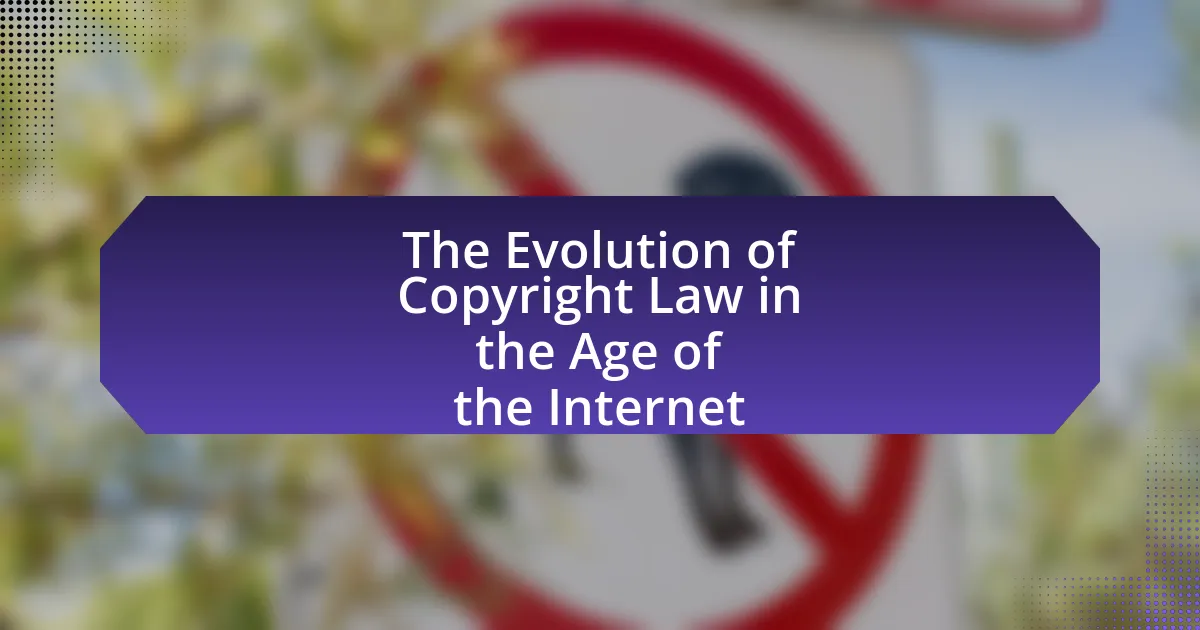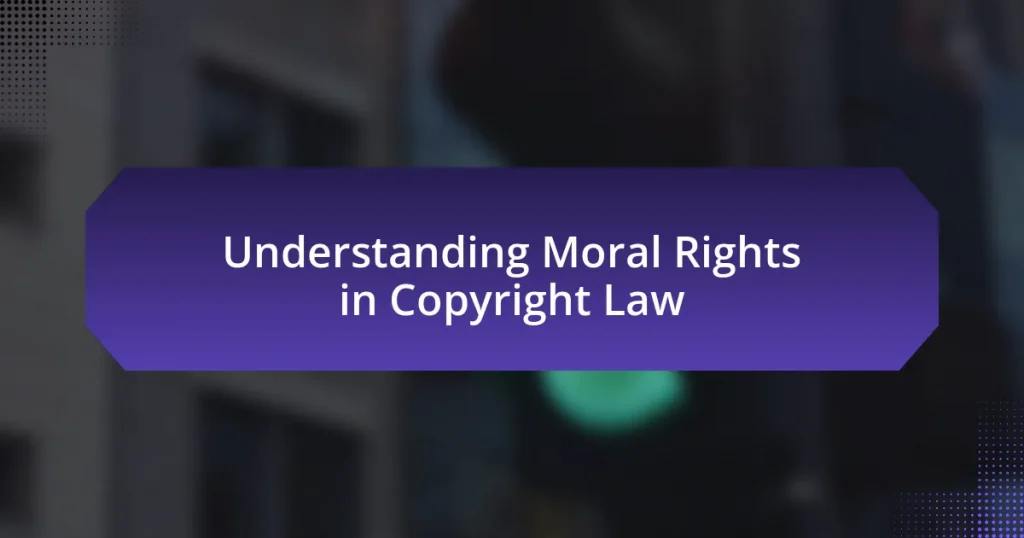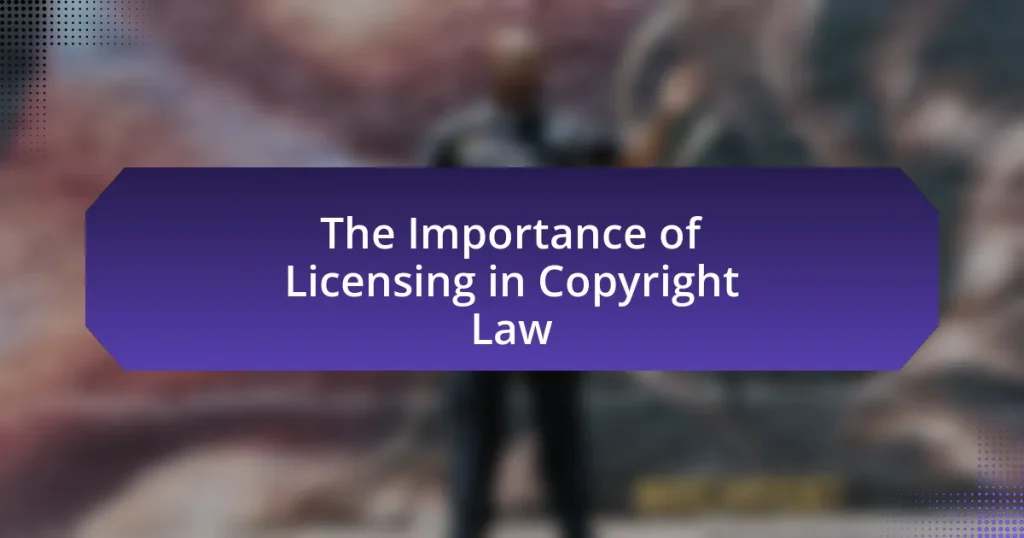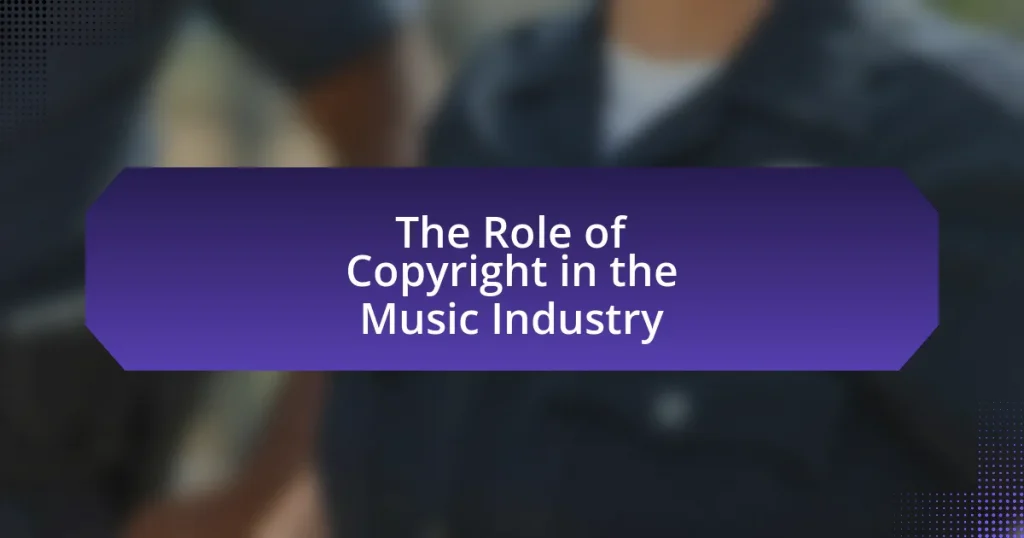The article examines the evolution of copyright law in the context of the Internet, highlighting significant changes that have occurred to address challenges such as digital piracy and content sharing. It discusses key historical milestones in copyright law prior to the digital age, the impact of the Digital Millennium Copyright Act (DMCA), and the influence of international treaties like the Berne Convention on online copyright protection. Additionally, the article explores the complexities of enforcing copyright across different jurisdictions, the importance of copyright in the digital landscape, and best practices for individuals and businesses to navigate copyright law effectively. Overall, it provides a comprehensive overview of how copyright law has adapted to the realities of the digital era.
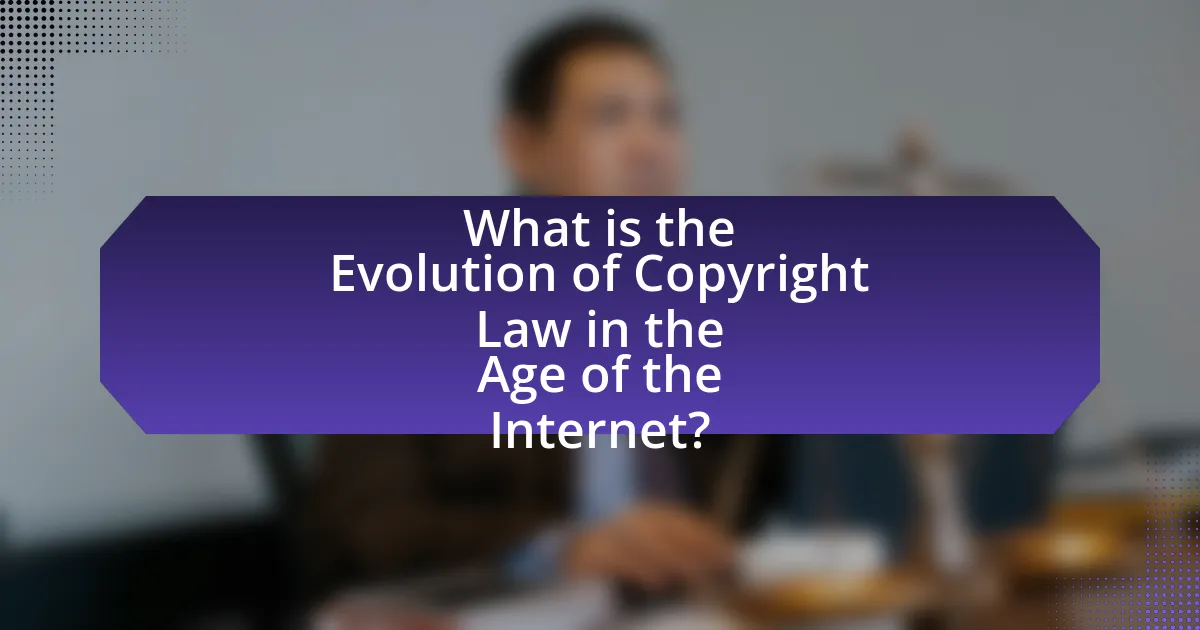
What is the Evolution of Copyright Law in the Age of the Internet?
The evolution of copyright law in the age of the Internet has been marked by significant changes to address the challenges posed by digital technology. Initially, copyright laws were established to protect creators’ rights in physical media, but the rise of the Internet introduced issues such as digital piracy and the ease of content sharing. In response, legislation like the Digital Millennium Copyright Act (DMCA) of 1998 was enacted in the United States to provide a framework for copyright protection in the digital realm, including provisions for safe harbors for online service providers. Additionally, international treaties such as the Berne Convention and the Agreement on Trade-Related Aspects of Intellectual Property Rights (TRIPS) have been adapted to include digital considerations. These developments reflect an ongoing effort to balance the rights of creators with the public’s access to information in an increasingly digital world.
How has the concept of copyright changed with the advent of the Internet?
The concept of copyright has evolved significantly with the advent of the Internet, primarily due to the ease of digital reproduction and distribution of creative works. Traditional copyright laws, which were designed for physical media, have struggled to adapt to the rapid sharing and accessibility of content online, leading to increased instances of infringement and piracy. For example, the Digital Millennium Copyright Act (DMCA) of 1998 was enacted to address these challenges by providing a framework for copyright protection in the digital environment, including provisions for the removal of infringing content and safe harbor protections for online service providers. This shift reflects a broader need for copyright law to balance the rights of creators with the public’s access to information in an increasingly digital world.
What were the key historical milestones in copyright law before the Internet?
The key historical milestones in copyright law before the Internet include the Statute of Anne in 1710, which is recognized as the first copyright law, granting authors exclusive rights to their works for a limited time. Following this, the Copyright Act of 1839 in the United States allowed authors to renew their copyrights, extending protection. The Berne Convention of 1886 established international copyright standards, ensuring that works were protected across member countries. The Copyright Act of 1909 in the U.S. expanded protection to include musical compositions and established a formal registration process. Finally, the Copyright Act of 1976 in the U.S. significantly revised copyright law, extending the duration of protection and introducing the concept of fair use. These milestones collectively shaped the framework of copyright law prior to the digital age.
How did the Internet challenge traditional copyright frameworks?
The Internet challenged traditional copyright frameworks by enabling widespread and instantaneous sharing of digital content, which undermined the control that copyright holders had over their works. This shift occurred as users began to easily copy, distribute, and modify content without permission, leading to significant legal and enforcement difficulties. For instance, the rise of peer-to-peer file sharing platforms in the late 1990s and early 2000s, such as Napster, demonstrated how quickly copyrighted material could be disseminated, prompting legal battles that highlighted the inadequacies of existing copyright laws to address digital realities. Additionally, the global nature of the Internet complicated jurisdictional issues, making it harder for copyright holders to enforce their rights across different countries.
Why is copyright law important in the digital age?
Copyright law is important in the digital age because it protects the rights of creators and ensures that they receive recognition and compensation for their work. In an era where digital content can be easily copied and distributed, copyright law serves as a legal framework that deters unauthorized use and piracy, which can undermine the economic viability of creative industries. For instance, the global music industry lost an estimated $12.5 billion in revenue due to piracy in 2019, highlighting the necessity of copyright protections to sustain artistic innovation and economic growth. Thus, copyright law is essential for fostering a fair digital environment that respects intellectual property rights.
What are the implications of copyright infringement online?
Copyright infringement online leads to legal consequences, financial penalties, and damage to the reputation of individuals or organizations involved. When copyrighted material is used without permission, copyright holders can pursue legal action, resulting in lawsuits that may impose significant monetary damages. For instance, the U.S. Copyright Act allows for statutory damages ranging from $750 to $30,000 per work infringed, and in cases of willful infringement, damages can escalate to $150,000 per work. Additionally, online platforms may face liability for hosting infringing content, prompting them to implement stricter content moderation policies. This legal framework aims to protect creators’ rights while balancing the need for access to information in the digital age.
How does copyright law protect creators in the digital landscape?
Copyright law protects creators in the digital landscape by granting them exclusive rights to their original works, including the right to reproduce, distribute, and display their creations. This legal framework ensures that creators can control how their works are used and monetized, thereby incentivizing creativity and innovation. For instance, the Digital Millennium Copyright Act (DMCA) provides mechanisms for creators to address copyright infringement online, allowing them to issue takedown notices against unauthorized use of their works. Additionally, copyright law adapts to digital formats, recognizing the unique challenges posed by the internet, such as easy replication and distribution of content. This adaptability is crucial for maintaining the integrity of creators’ rights in an evolving digital environment.

What are the major developments in copyright law due to the Internet?
Major developments in copyright law due to the Internet include the introduction of the Digital Millennium Copyright Act (DMCA) in 1998, which established rules for online copyright infringement and safe harbors for internet service providers. The DMCA aimed to address the challenges posed by digital content distribution, making it illegal to circumvent digital rights management (DRM) technologies. Additionally, the rise of user-generated content platforms led to the implementation of the “notice-and-takedown” system, allowing copyright holders to request the removal of infringing content. These developments reflect the need to balance copyright protection with the realities of digital sharing and distribution, as evidenced by ongoing legal cases and legislative updates that continue to shape the landscape of copyright law in the digital age.
How have international treaties influenced copyright law online?
International treaties have significantly shaped online copyright law by establishing standardized protections and enforcement mechanisms across borders. For instance, the Berne Convention for the Protection of Literary and Artistic Works mandates that member countries recognize the copyright of works from other member states, thereby facilitating international copyright protection. Additionally, the Agreement on Trade-Related Aspects of Intellectual Property Rights (TRIPS) requires World Trade Organization members to adhere to minimum standards of copyright protection, including the duration of protection and enforcement measures. These treaties have led to a more cohesive global framework, enabling creators to safeguard their works in the digital environment and ensuring that copyright laws adapt to the challenges posed by the internet.
What role did the Berne Convention play in shaping digital copyright?
The Berne Convention established foundational principles for copyright protection that significantly influenced digital copyright. By mandating that member countries recognize and enforce copyright for works originating in other member states, the Convention facilitated international protection of digital content. This framework laid the groundwork for modern digital copyright laws, ensuring that creators’ rights are upheld across borders, which is crucial in the global digital landscape. The Convention’s emphasis on automatic protection without the need for formal registration has also been pivotal in adapting copyright to the fast-paced nature of digital distribution, allowing creators to retain rights from the moment of creation.
How did the Digital Millennium Copyright Act (DMCA) impact copyright enforcement?
The Digital Millennium Copyright Act (DMCA) significantly strengthened copyright enforcement by introducing legal protections for digital content and establishing a framework for addressing online copyright infringement. The DMCA criminalizes the circumvention of digital rights management (DRM) technologies, thereby deterring unauthorized access to copyrighted works. Additionally, it provides a “safe harbor” provision for internet service providers (ISPs) and online platforms, allowing them to avoid liability for user-generated content as long as they promptly remove infringing material upon notification. This legal structure has led to increased compliance among online platforms and has facilitated the removal of infringing content, thereby enhancing the overall enforcement of copyright laws in the digital environment.
What challenges do copyright laws face in the age of the Internet?
Copyright laws face significant challenges in the age of the Internet due to the ease of digital reproduction and distribution. The rapid proliferation of online content makes it difficult to enforce copyright protections, as unauthorized sharing and piracy occur at unprecedented rates. For instance, a 2020 report by the International Intellectual Property Alliance estimated that the U.S. economy loses approximately $29 billion annually due to online piracy. Additionally, the global nature of the Internet complicates jurisdictional issues, making it challenging for copyright holders to pursue legal action across different countries. Furthermore, the rise of user-generated content platforms blurs the lines of ownership and fair use, leading to disputes over what constitutes infringement. These factors collectively undermine the effectiveness of traditional copyright frameworks in protecting intellectual property in the digital landscape.
How do issues of fair use complicate copyright enforcement online?
Issues of fair use complicate copyright enforcement online by creating ambiguity around what constitutes permissible use of copyrighted material. Fair use allows for limited use of copyrighted works without permission under specific circumstances, such as criticism, comment, news reporting, teaching, scholarship, or research. This ambiguity leads to challenges in enforcement, as content creators and platforms may interpret fair use differently, resulting in inconsistent application of copyright laws. For instance, the 2014 case of “A&M Records, Inc. v. Napster, Inc.” highlighted how fair use can be subjective, complicating the ability of copyright holders to protect their works effectively in a digital environment where content is easily shared and reproduced.
What are the challenges of enforcing copyright across different jurisdictions?
Enforcing copyright across different jurisdictions presents significant challenges due to variations in national laws, enforcement mechanisms, and cultural attitudes towards copyright. Each country has its own legal framework governing copyright, which can lead to inconsistencies in protection and enforcement. For instance, the United States operates under a “fair use” doctrine that allows for certain uses of copyrighted material without permission, while many European countries have stricter rules that do not permit such flexibility.
Additionally, the lack of a unified international copyright treaty complicates enforcement, as countries may not recognize or enforce foreign copyright claims. The Berne Convention provides some framework for international copyright, but it does not mandate uniform enforcement practices. This results in difficulties for copyright holders seeking to protect their works globally, as they must navigate diverse legal landscapes and may face challenges in obtaining remedies for infringement.
Moreover, technological advancements and the rise of the internet have facilitated the rapid dissemination of copyrighted material across borders, often outpacing existing legal frameworks. This creates enforcement issues, as copyright holders struggle to track and address infringements that occur in jurisdictions where they may have limited legal recourse.

How can individuals and businesses navigate copyright law in the digital age?
Individuals and businesses can navigate copyright law in the digital age by understanding the principles of copyright, utilizing licensing agreements, and employing digital tools for copyright management. Knowledge of copyright basics, such as the rights granted to creators and the duration of protection, is essential for compliance. Licensing agreements allow users to obtain permission for the use of copyrighted materials, ensuring legal use while respecting creators’ rights. Additionally, digital tools like copyright management systems and online databases can help track usage and protect intellectual property. According to the U.S. Copyright Office, the digital landscape has transformed how copyright is enforced and managed, making it crucial for users to stay informed about changes in legislation and best practices.
What best practices should creators follow to protect their work online?
Creators should follow several best practices to protect their work online, including using copyright notices, registering their work, employing digital rights management (DRM), and utilizing watermarks. Copyright notices inform users of the creator’s rights, while registration provides legal evidence of ownership, which can be crucial in disputes. Digital rights management tools help control how the work is used and distributed, and watermarks deter unauthorized use by marking the content visibly. According to the U.S. Copyright Office, registered works are eligible for statutory damages and attorney’s fees in infringement cases, reinforcing the importance of these practices.
How can creators effectively register their copyrights in the digital space?
Creators can effectively register their copyrights in the digital space by utilizing online registration services provided by copyright offices, such as the U.S. Copyright Office’s eCO system. This system allows creators to submit their works electronically, streamlining the process and reducing registration time. According to the U.S. Copyright Office, registering a work provides legal benefits, including the ability to sue for infringement and eligibility for statutory damages. Additionally, creators should maintain records of their work’s creation, including drafts and timestamps, to establish ownership. This practice is supported by the Digital Millennium Copyright Act, which emphasizes the importance of documentation in digital copyright claims.
What steps can businesses take to ensure compliance with copyright laws?
Businesses can ensure compliance with copyright laws by implementing a comprehensive copyright policy, conducting regular training for employees, and utilizing copyright management tools. A well-defined copyright policy outlines the procedures for using copyrighted materials, ensuring that employees understand the importance of respecting intellectual property rights. Regular training sessions help employees recognize copyright issues and the consequences of infringement, fostering a culture of compliance. Additionally, copyright management tools, such as digital rights management software, assist in tracking and managing the use of copyrighted content, thereby reducing the risk of unintentional violations. These steps collectively help businesses navigate the complexities of copyright law in the digital age.
What resources are available for understanding copyright law in the Internet era?
Resources available for understanding copyright law in the Internet era include government websites, legal textbooks, online courses, and academic journals. Government websites, such as the U.S. Copyright Office, provide official guidelines and updates on copyright regulations. Legal textbooks, like “Copyright Law: Essential Cases and Materials” by Robert A. Gorman and Jane C. Ginsburg, offer comprehensive insights into copyright principles. Online platforms, such as Coursera and edX, host courses on copyright law, often taught by law professors. Academic journals, including the “Harvard Journal of Law & Technology,” publish articles that analyze current issues and developments in copyright law as it pertains to digital content. These resources collectively enhance understanding of copyright law in the context of the Internet.
Where can individuals find legal assistance regarding copyright issues?
Individuals can find legal assistance regarding copyright issues through various resources, including law firms specializing in intellectual property, legal aid organizations, and online platforms that connect users with attorneys. Law firms often provide tailored advice and representation for copyright disputes, while legal aid organizations may offer free or low-cost services to those who qualify. Additionally, websites like the American Bar Association’s “Find Legal Help” tool can help individuals locate copyright attorneys in their area, ensuring access to professional guidance in navigating copyright law complexities.
What online tools can help in managing copyright for digital content?
Online tools that assist in managing copyright for digital content include Creative Commons, which provides licenses that allow creators to specify how their work can be used, and Copyright.gov, the official U.S. government site for copyright registration and information. Additionally, tools like DMCA.com offer services for Digital Millennium Copyright Act takedown notices, while services like Pixsy help track and enforce copyright infringement for images. These tools are essential for creators to protect their intellectual property rights in the digital landscape.
